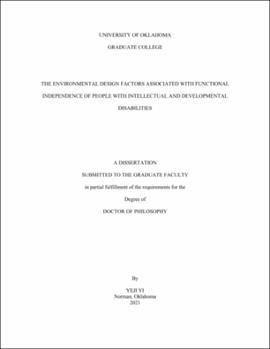| dc.description.abstract | Background: The increasing number of students are receiving special education services, and the majority of the students have identified as having cognitive challenges. Prior studies have explored the associations between the environment and students’ behavior in the form of Evidence-based design (EBD) and evidence-based practice (EBP). A systematic review on EBD and EBP has identified 26 design strategies, which have the potentials to have positive impacts on students’ behaviors. However, these environmental features’ effectiveness has not been adequately addressed due to limited study design and small sample sizes. Efforts to creating inclusive environments for people with intellectual and developmental disabilities (IDD) have heavily relied on experts’ opinions or limited evidence.
Purpose: The primary goal of the presented study is to analyze the relationship between the identified 26 environmental factors and students’ adaptive and problem behaviors. Through empirical investigation, this study aims to prescribe these environmental attributes as evidence-based design guidelines for people with intellectual and developmental disabilities (DG-IDD).
Method: Data were collected through an online survey between February 17 and March 24, 2021. The survey consisted of the Environmental Evaluation (EE), Performance Measure (PM), and the Brief Problem Monitor (BPM), which measured environmental attributes, adaptive behavior, and problem behavior, respectively. The collected 168 survey responses were used for factor analyses, multiple imputations, and regression analyses.
Results: Factor analyses categorized the DG-IDD items into four components: affordance, restoration, control, and coherence. Results of multiple regression analyses supported that a set of the DG-IDD positively predict students’ adaptive behaviors when their disability levels were controlled (the Environ-Adaptive Behavior model; F (2, 90.13) = 25.363, R2 = 0.278, p = .000). Specifically, restorative features were associated with conceptual/practical skills (F (2, 383.04) = 31.77, R2 = 0.301, p = .000), and the controllable characteristics were relevant to social skills (F (2, 37.77) = 12.068, R2 = 0.181, p = .000). The regression analyses did not support that DG-IDD inversely predicted problem behaviors (the Environ-Problem Behavior model; F (1, 43.42) = 3.244, R2 = 0.034, p = .079). The collected data did not support any associations between the design features and internalizing or externalizing problem behaviors. However, correlation analysis displayed the negative relationship between the DG-IDD and the problem behaviors (R = -0.191, p = 0.029). Furthermore, controllable features were associated with reduced attentional problem behaviors controlling students’ ages and disability levels (F (3, 68.15) = 5.195, R2 = 0.110, p = .003).
Conclusion: The preliminary analysis indicated that educational settings that have the DG-IDD items are associated with more frequent occurrence of adaptive behaviors while fewer problem behaviors of students with IDD. | en_US |
